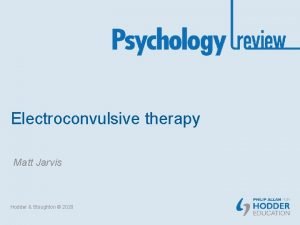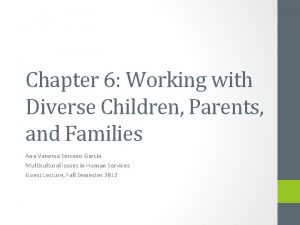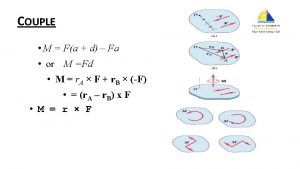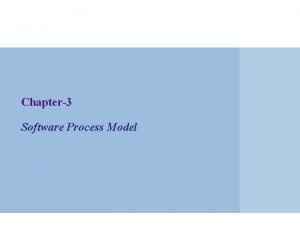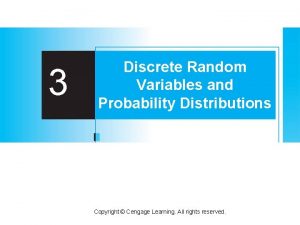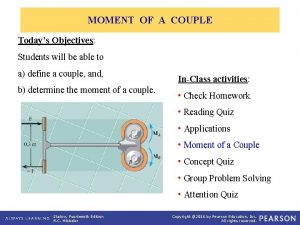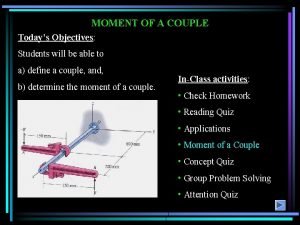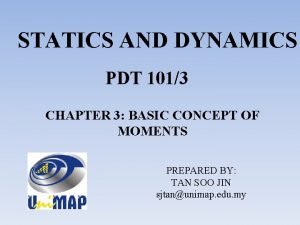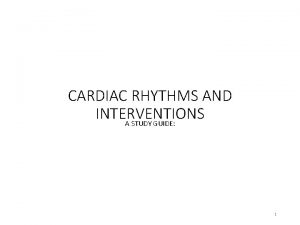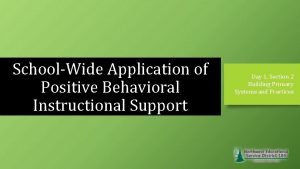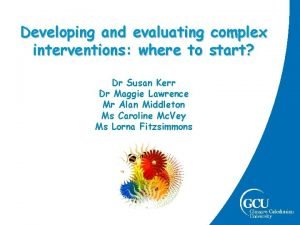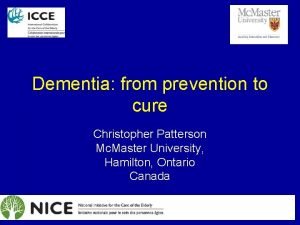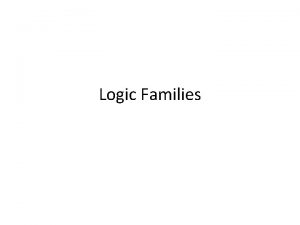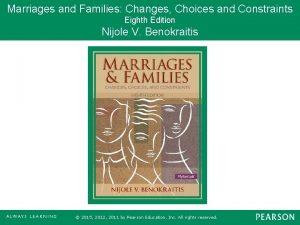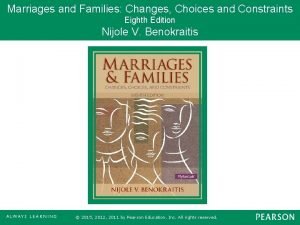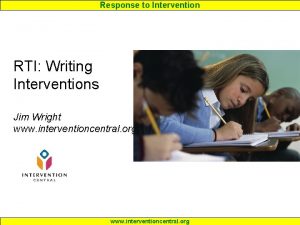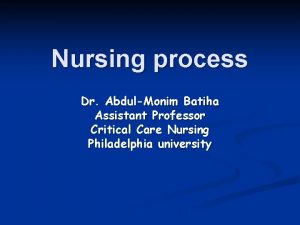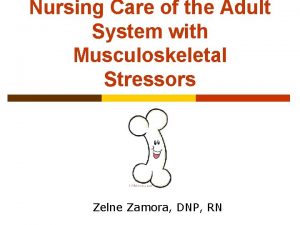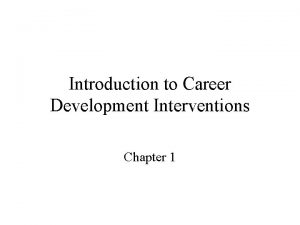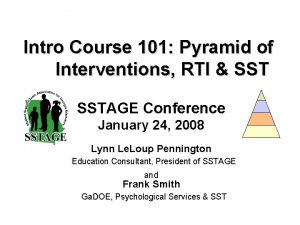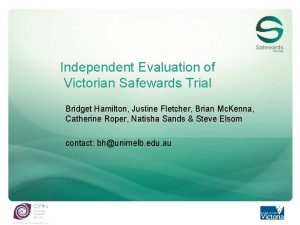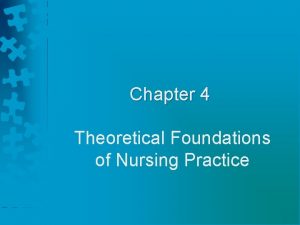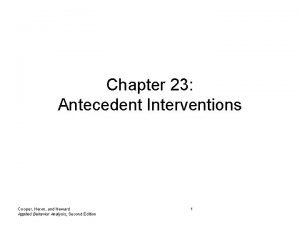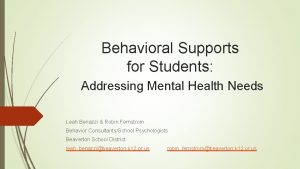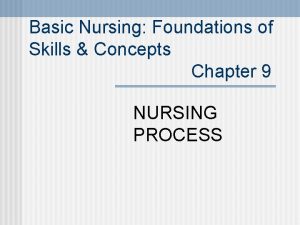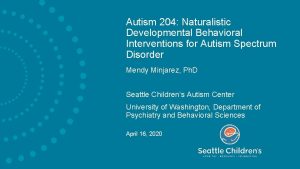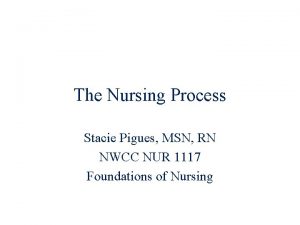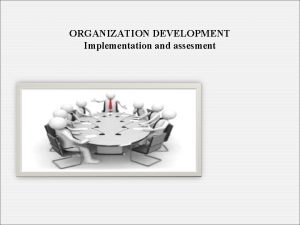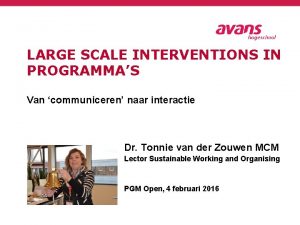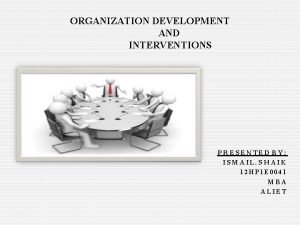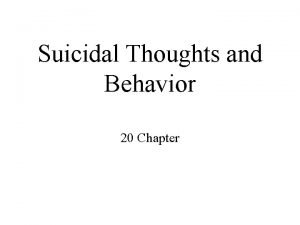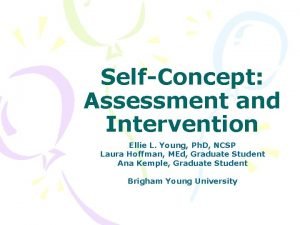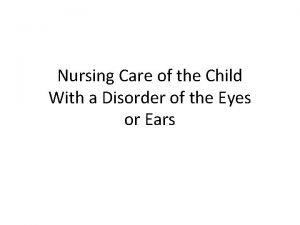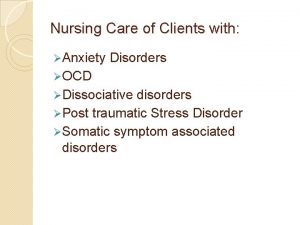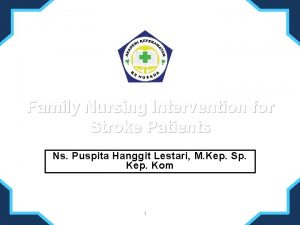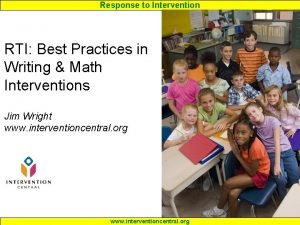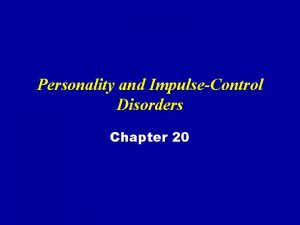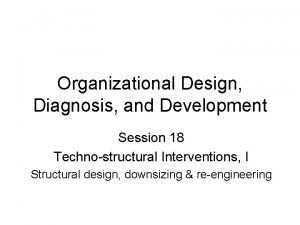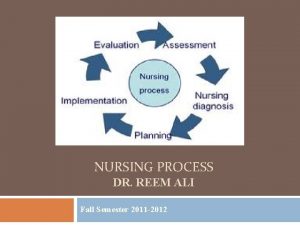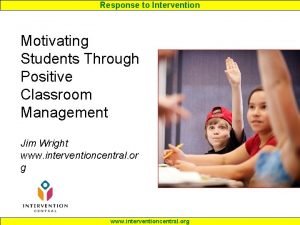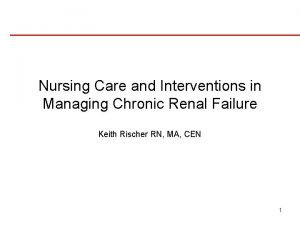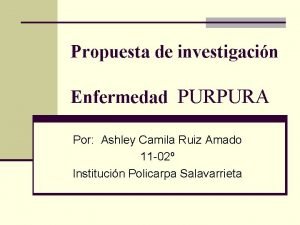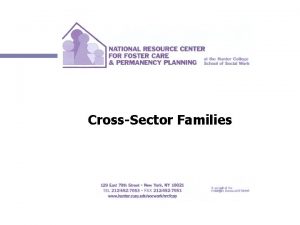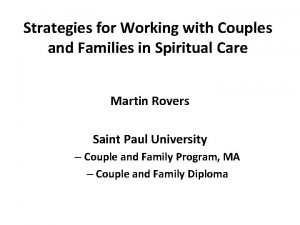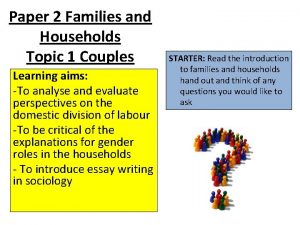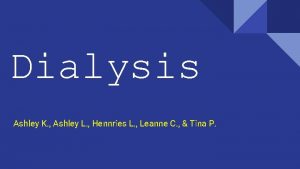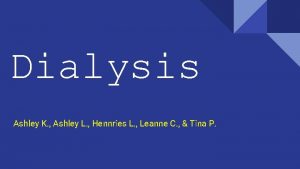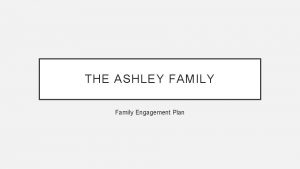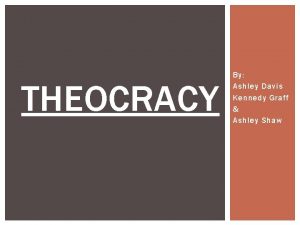Theories and Interventions with Couples and Families Ashley










































































































- Slides: 106

Theories and Interventions with Couples and Families Ashley K. Randall, Ph. D University of Fribourg March 11 -12, 2016

The Need to Belong (Baumeister & Leary, 1995) �People have a basic psychological need to feel closely connected to others, and that caring, affectionate bonds from close relationships are a major part of human behavior.

6 Components of Intimacy Knowledge: � intimate partners have extensive personal, often confidential, information about each other Caring: � intimate partners feel more affection for one another than they do for most others Interdependence: � intimate partners have strong, diverse, and enduring influence on each other Mutuality: � intimate partners think of themselves as a couple instead of as two entirely separate individuals

Mutuality – Self & Other (we-ness)

6 Components of Intimacy, cont. �Trust: intimate partners expect treatment from one another that is fair, honorable, not harmful, and responsive to their needs �Commitment: intimate partners expect their relationship to continue, and they work to realize that goal

Relationships can be GOOD for you… �Happiness �Reduced stress �Fewer mental health problems �Feel reduced pain �Longer life

…but they can also be BAD for you. �Negative effects on overall health �Stress upon stress Marital distress chronic stressor �Poor mental health �Increased risk for heart disease �Slower disease recovery

IR & Psychopathology STRESS (Negative) Emotions Mental Health Stress Spillover STRESS (Negative) Emotions Mental Health

Research Suggests � Nearly 30% of cases of MDD among married individuals could be prevented if the distress was prevented or treated. � Depression in one partner is associated with lower marital satisfaction in the other partner (e. g. Coyne, 1987). � The correlation between diagnosed depression and marital quality are -. 66 for both men and women. Actor effects ▪ psychopathology develops as a result of (poorly) coping with problems in their relationship. Partner effects ▪ the effect of one partner’s psychopathology on their partner’s relationship satisfaction.

Causes Associated with Relationship Distress

Stress

Typologies of Stressors �Locus (External vs. Internal) �Intensity (Major vs. Minor) �Duration (Acute vs. Chronic)


Implications “Understanding how stress can promote or hinder well -being in close relationships is important because relationship quality is the primary predictor of life satisfaction (e. g. , Ruvolo, 1998) …. it [relationship quality] may play a causal role in promoting physical health (e. g. , Burman & Margolin, 1992; Schmaling & Goldman Sher, 2000), emotional well-being and resistance to depression (e. g. , Tesser & Beach, 1998). ” (Randall & Bodenmann, 2009, p. 114)

Communication 93%

Functions of Nonverbal Communication � Providing Information A person’s moods and meaning are usually evident in his or her nonverbal behavior. � Regulating Interaction Subtle nonverbal cues allow people to take turns in a conversation smoothly. � Defining the Nature of the Relationship Nonverbal actions express intimacy and carry signals of power and status.

Nonverbal Sensitivity � Women work harder at nonverbal communication Women send clearer, more comprehensible messages, and they attentively interpret others’ behavior more accurately � When spouses communicate poorly, both of them make a lot of mistakes, but the husbands usually make more of them.

Miscommunication – Dysfunctional Relationship Patterns �Kitchen-Sinking �Off-Beaming �Mind reading �Interrupting �“Yes Butting” �Cross Complaining

Addressing Negative Communication �XYZ statements combine behavior descriptions with I-statements: “When you do X in situation Y, I feel Z. ” �Active Listening �Validate �Stay Cool

Events that Cause Conflict �Criticism is behavior that seems unjustly critical, being perceived as demeaning or derogatory �Illegitimate demands are requests that are excessive and that seem unjust �Rebuffs occur when one’s appeals for help or support are rejected �Cumulative annoyances are relatively trivial events that become irritating with repetition

Conflict �Interpersonal conflict occurs whenever one person’s motives, goals, beliefs, opinions, or behavior interfere with, or are incompatible with, those of another. �Tension between: personal autonomy and close connection to others; openness versus closedness; stability versus change; integration with, versus separation from, a social network.

Conflict, cont. �Dating couples report 2. 3 conflicts per week �Spouses experience 1 -2 disagreements/month �Amount of conflict is due to: Personality – neuroticism vs. agreeableness Attachment – anxiety vs. avoidance Stage of life – older couples have fewer conflicts than younger couples do Similarity – the less similar partners are to each other, the more conflict they experience Alcohol – intoxication exacerbates conflict; adding alcohol to a frustrating disagreement is a bit like adding fuel to a fire

Dealing with Conflict: 4 Types of Couples � Volatile couples have frequent and passionate arguments, but they temper their fights with plenty of wit and evident fondness for each other. � Validators fight more politely and calmly, behaving more like collaborators than antagonists. � Avoiders rarely argue; they duck confrontation and often just try to fix problems on their own. � Hostiles fight with criticism, contempt, defensiveness, and withdrawal, and their marriages are more fragile than those of the other three groups.

Speaker-Listener Technique � Rules: The speaker has the floor Share the floor No problem solving Speaker: Speak for yourself (don’t try to be a mind reader) Speaker: Stop and let the listener paraphrase Listener: Paraphrase what you hear Listener: Focus on the speaker’s message. Don’t rebut.

Can Fighting be Good? The more unexpressed nuisances and irritants partners have, the less satisfied with their relationships they tend to be. So, the prevailing view among conflict researchers is that conflict is an essential tool with which to promote intimacy. It is the deft management of conflict—and not its absence—that allows relationships to grow and prosper.

Need for Marriage & Family Therapy

Reasons for Working with Families vs. Individuals (Gladding, 2014) � Provides: flexibility in conceptualizing cases from both linear and circular causality perspectives increased complexity and treatment options for clients � Involves other real, significant people in the treatment process and brings the action into the room � All family members receive treatment interventions simultaneously � Family therapy tends to be briefer than individual counseling

Understanding Family Tx �Family therapy for the most part focuses on making changes in the family system Individual counseling is more intrapersonal Group counseling is more interpersonal �Client satisfaction is high 97% satisfaction rates

Theoretical Context of Family Tx Gladding, Ch. 2

Defining Family �Definition is not monolithic and varies according to cultural group �Families are systems in which the members interact with one another �Family members influence each other and, in turn, are influenced by each other

Understanding Systems • Each element affects all other elements of the system • Principles of a system (Bertalanffy, 1969) • Whole greater than the sum of its parts • Compilation of subsystems arranged in a hierarchical structure • E. g. , Grandparents, children • Self regulates to maintain homeostasis • Co-regulation vs. dysregulation?

Feedback Loops • Communication process within a system • Negative feedback loops = error activated E. x: When family initiates corrective action upon awareness of deviation from some standard • Positive feedback loops = deviation amplification Works to enhance changes from a set point ▪ E. x. : Set up intervention for addict to go to rehab and introduce therapists and counseling to help in recovery

Family Development

Individual & Family Development �Useful to study families from a developmental perspective the predictable changes that occur in individuals and families over time �Development takes into consideration: Individual time (birth death) Social time (e. g. , marriage) Historical time (culture)

Family Development: Six-Stage Life Cycle • Six-stage life cycle of intact middle-class, nuclear family developed by Mc. Goldrick et al. (2011) 1. Single young adults leaving home 2. The new couple 3. Families with young children 4. Families with adolescents 5. Families launching children and moving on 6. Families in later life

1. Single Young Adults: Leaving Home � Disconnect and reconnect with one’s family on a different level and to develop a strong identity – a “solid self” � Cohabitation is increasing � Singlehood is a viable alternative to marriage � Singles are the second happiest group Married couples being the happiest � Singles must: establish social networks, find meaning in work or avocations, and live a balanced life to be physically and psychologically healthy � Therapy: singles typically seek family therapy due to a weak sense of self, inability to separate from their family of origin, and a lack of social skills to establish significant relationships with others

2. New Couple � Begins with courtship (i. e. , dating) � Role of attachment � Period of adjustment and compromise quite satisfying for those who are able to resolve differences successfully – they maintain a high level of idealistic distortion about their relationship � Can result in divorce for those unable to make the necessary adjustments � Therapy: new couples typically seek family therapy due to the inability to adjust to living as a couple instead of individually, difficulty with relatives (in laws and/or family of origin), inability to develop effective communication and problem solving skills, and differences over whether and when to have children

3. Families w/ Young Children � Dramatic changes in lifestyle which stress a couple's lifestyle and marital relationship new parenting/maternal demands and unbalances the patterns and interactions previously developed (temporary) � Marital satisfaction tends to decrease in this stage strong marital bonds can mediate the stresses associated with children and work issues � Therapy: families with young children typically seek family therapy due to inability to reorganize and restructure following the arrival of children as well as differences over how to raise and discipline children

4. Families w/ Adolescents � � Most active, exciting and stressful Sandwich generation � Therapy: families with adolescents typically seek family therapy due to parent-adolescent conflict, developmental and psychological stress of marital partners who see their dreams 'slipping away, ' and the stresses involved with caring for multiple generations of family members as well as for themselves

5. Launching Children � ”Empty nest” � Positive time for couples rediscovering the couple relationship and enjoying new freedoms from responsibility � Negative time for couples those who defined themselves primarily as parents and have been heavily focused on their children � Therapy: families in the launching and moving on stage typically seek family therapy due to a sense of loss of self, the marriage or the child who has left; conflict with the child who is not independent enough; or frustration/anger over the marriage and/or career ambitions

6. Families in Later Life � Decline in finances, health, loss of spouse, chronic illness, depression, and helplessness � Positive aspects: interacting with grandchildren, doing what one wants and setting one's own pace, and reflecting on important life activities � Therapy: families in later life typically seek family therapy due to a lack of meaning or enjoyment in life, concern over the aging process, the lack of quality relationships with family members (e. g. , children, in-laws, grandchildren)

Implications of Life Cycles on Family Therapy (Gladding, 2014) � The 'fit' between therapist and the family can influence the outcome of therapy � Problems associated with: Therapist’s lack of experience Current life-stage of therapist � Race, gender, ethnicity, class, sibling position, and sexual orientation of therapist can positively or negatively influence the 'fit' and outcome of therapy Increasing multicultural sensitivity

Types of Functionality of Families Gladding, Ch. 3

Types of Families • • • Nuclear family Single-parent family Blended family Dual-career family Child-free family • • • Special-needs-child/children family Aging family Multigenerational family Grandparent-headed family Military family LGBT family

Qualities of Healthy Families �Health ethical accountability (i. e. promoting good relationships and balancing give and take) among family members �Characteristics Commitment Appreciation Spend time together Effective communication Clear roles Ability to deal with a crisis (adaptable)

Adaptability: Ability to Deal w/ Crisis �Ambiguous Loss �Lack of Control

Coping Strategies in Families �ABC-X Model Process between a stressor (A-variable; typically a severe critical life event) and a potential crisis (Xvariable) Moderated by: ▪ Family resources (B-variable) ▪ Family’s definition of the problem (C-variable) �Systemic Transactional Approach (Bodenmann, 1995) Highlights interdependence between partners Dyadic coping how partners cope together as a unit

Therapeutic Approaches to Working with Families Gladding, Ch. 7

YOUR ROLE: “Should be a healer” – Minuchin OVEREMPHASIZED UNDEREMPHASIZED � Details Content Process � Making everyone happy � Verbal expression Words are not remembered Must model behavior � Reaching a resolution too � Establishing early � Dealing w/one member Scapegoat structure/boundaries Role of informed consent (p. 153) � Showing care and concern SOLER � Engaging family in the Tx Process � Attending to non-verbal family dynamics

Family Tx Process: Pre-Session �Tx begins at the first moment of interaction �Person that initiates tx “most interested in change” �Make appointment ASAP (w/in 48 hours) �Hypothesize about family dynamics

Family Tx Process: Initial Session �Initial Session Most critical in terms of outcomes ▪ Structure ▪ Supportive behaviors Joining develop trust b/w family members Observe the family dance ▪ Systems ▪ Boundaries

Family Tx Process: Middle Phase �Middle Phase of Tx Make sure all members are involved ▪ Circular Questioning Quid Pro Quo Emphasize change Reinforce new behaviors Focus on the process

Family Tx Process: Termination � Occurs for the following: Tx goals have been met the couple or family's problem exceeds the skills/competency of therapist the couple or family are no longer benefiting from therapy � Process: orientation summarization discussion of long-term goals follow-up and relapse prevention � Termination is often premature, with 40% to 60% of families dropping out before therapy is finished

Therapeutic Approaches: Psychodynamic & Bowen Family Tx

Psychodynamic Family Tx �Major Tenets Interlocking Pathology Object Relations Theory ▪ “relations between persons involved in ardent emotional attachments” ▪ children often internalize good and bad characteristics of these objects within themselves ▪ form the basis for how individuals interact and evaluate their interpersonal relationships ▪ evaluating relationships can result in splitting (viewing object representations as either all good or all bad) ▪ splitting helps people control their anxiety and even their objects, by making them predictable

Tx Techniques & Role of Therapist � Techniques Transference Dream Analysis Confrontation Focus on strengths Life history � Therapists Role “Good enough mother” Teacher Catalyst (e. g. , activates, challenges, confronts, interprets, integrates family processes) Emphasizes on family as well as individual interactions

Process & Outcome �Therapist’s interpretation of events Family members’ insight ▪ Insight translated into new and more productive ways of behaving and interacting �Differentiation (i. e. , balance of rational and emotional selves and separation of self and others in a non-anxious way) if differentiation is not possible, crisis resolution (reduction in symptoms) is utilized, focusing more on supporting defenses and clarifying communication

Unique Aspects � Focus on unconscious influence on human behavior � Raises awareness of intrapersonal and interpersonal connections, such as invisible loyalties � Examines basic defense mechanisms and their influence on family interactions � Emphasizes the historical origins of dysfunctions and the treatment of persons and families so affected (e. g. , attachments)

Bowen Family Therapy �Theory = Therapy “Family is a natural system” �Families need to correct patterns passed down from generations Focus is on the past �Families have a physical and emotional anxiety Low vs. High level of differentiation

Tx Techniques � Going home again return home to get to know their family of origin better individuals may need to practice staying calm before returning home � Detriangulation the process of being in contact and emotionally separate two levels ▪ resolving anxiety over family situations and not projecting feelings onto others ▪ separating one’s self from becoming a focus when tension or anxiety arises in the family, avoiding scapegoating or blaming

Tx Techniques, cont. � Person-to-person relationships Helping two family members relate to each other about each other without talking about others or about impersonal issues � Differentiation of self The degree to which a person is able to distinguish between the subjective feeling process and the more objective intellectual (thinking) process May nvolve all the previous techniques as well as confrontation between family members and therapist

Role of Therapist � Coach/teacher � Have family members talk through therapist Reduces emotional reactivity � Setting an example of a reasonable, neutral, self- controlled adult � Differentiation of therapist is crucial objectivity and neutrality are important therapist characteristics � Interpret multigenerational patterns

Process & Outcome � Family members will Understand intergenerational patterns ▪ gain insight into historical experiences that influence current interactions Increase levels of differentiation � Primary unit of treatment is the individual or couple Whole families usually not seen � Best outcome is when partners work together as a team

Unique Aspects �Focus on family history Avoid repeating negative patterns �Use of the genogram �Systemic in nature �Cognitive orientation �Effective with individuals or client families

Theories and Interventions with Couples and Families Ashley K. Randall, Ph. D University of Fribourg March 11 -12, 2016

Therapeutic Approaches: Experiential Family Tx

Experiential Family Therapy �Emerged from Humanistic and Existential movement Humanistic: people are good, honest emotions Existential: freedom of choice �Built upon ideas of: Gestalt Psychodrama Client-centered

Experiential Family Tx. , cont. �Individuals are not aware of or suppress their emotions Results in a climate of ‘emotional deadness’ where people avoid each other Emphasis on expression of feelings and increased sensitivity �Focus is on the present Concentration on increasing self-awareness by actively experiencing the here and now

Virginia Satir � Focus on communication and individual self- expression � Satir’s observations Emotional deadness Cold affect Don’t enjoy the family Lack of warmth Avoidance by work/school

Dysfunctional Communication �Blamer: attempts to place the focus on others �Placater: avoids conflict �Distractor: makes irrelevant statements �Computer (rational analyzer): acts in super- reasonable ways

Satir’s Tx Techniques �Treatment Techniques: “I” messages ▪ Promoting good, direct communication Sculpting ▪ Creating a scene and acting it out (psychodrama) Choreography Humor Props Family Reconstruction (i. e. Family Maps - Bowen)

Carl Whitaker �Absurdity! �Techniques: 1) Redefine symptoms of as efforts for growth 2) Model fantasy alternatives to real-life stressors 3) Separate intra- and inter-personal stress 4) Add practical bits of intervention 5) Augment the despair of a family member 1) Enlarge the feelings of the family member 6) Promote affective confrontation 7) Treat children like children and not peers

Other Experiential Techniques � Joint family scribble Each member makes a brief scribble, followed by the whole family incorporating their scribbles into a unified picture Promotes awareness of what it is to work both individually and together � Conjoint family drawing Each family member draws a picture “as you see yourself as a family” � Symbolic drawing of family life space Therapist draws a large circle and instructs family members to include within the circle everything that represents the family and to place outside the circle everything those people and institutions that are not part of the family Family is instructed to symbolically arrange themselves, through drawing, according to how they relate to each other Family is asked to discuss what was drawn and why, as well as to share each members perspective on family dynamics and interactions

Role of Therapist � Therapist is an active participant � Satir’s model therapist is a facilitator and resource person who helps families understand themselves and others better and promotes clear communication � Whitaker’s model therapist at times engages in spontaneous and absurd activities designed to raise emotion, anxiety, and insight and to break down rational defenses � Generally, experiential family therapists: establish a warm, accepting, caring, respectful, hopeful environment with an orientation toward change and improvement verbalize presuppositions of hope the family has promote growth through stimulating experiences that provide opportunities for existential encounter behave as real, authentic people do not encourage projection or act as blank screens for families

Process & Outcome � Tx is designed to promote individual growth without an overriding concern for the needs of the whole family � Satir: Chaos is when people are engaged in tasks, taking risks, sharing hurt and pain Integration and closure occurs as issues are worked on and family members understand themselves and issues more thoroughly � Whitaker: Engagement: when therapists become personally involved with their families through the sharing of feelings, fantasies, and personal stories Involvement: when therapists concentrate on helping the families try new ways of relating through the use of playfulness, humor, and confrontation Disentanglement: families have made constructive changes and rules and roles have been modified � Primary goal of therapy is growth, sensitivity, the sharing of feelings, and congruence between inner experiences and outward behaviors � Family must win the ‘battle for initiative, ’ becoming actively involved and responsible for making changes

Unique Aspects �Focus on immediate experiences �Short Tx length More direct than psychodynamic/Bowen �Emphasizes individuals as well as structures within the change process �Lack of empirical research

Therapeutic Approaches: Structural Family Tx

Premise of the Theory �Family Structure Invisible set of functional demands that organizes the family �Coalitions Stable – fixed and inflexible Detouring – adding 3 rd member to alleviate stress

Major Focus � Subsystems Spousal subsystem Parental subsystem Sibling subsystem � Boundaries clear boundaries: rules and habits that enhance clear communication and relationships rigid boundaries: inflexible and keep people separated from each other, making it difficult to relate in intimate ways, and may result in emotional detachment from other family members diffused boundaries: do not have enough separation among family members and encourage dependence � Triangulation

Treatment Focuses on: �Family issues originate from dysfunctional sets Family reactions developed in response to stress! �Want to “perturb” the system

Tx Techniques: Joining �Joining Therapist joins the family by engaging all members of the family How to: ▪ Tracking follows the facts using open-ended questions ▪ Mimesis becomes like the family (verbal) ▪ Confirmation confirms observations of the family ▪ Accommodation makes personal adjustments in order to achieve alliance

Tx. Techniques: Changing the System � Reframing Changing a perception/meaning of a situation � Punctuation Enhances the change in the system Focus on communication � Unbalancing Supporting system against another (e. g. underdog) � Enactment See how family members interact Helps to examine roles

Tx. Techniques, cont. � Work w/Spontaneous Interactions � Boundary Making � Intensity Change tone, volume and choice of words � Restructuring Alter hierarchy

Role of Therapist � Observer/expert � Requires high energy and precise timing � Therapist role changes over the course of therapy: 1 st phase: joins the family and takes a leadership position 2 nd phase: maps out the underlying family structure Final phase: helps transform the family structure � Therapist is never a ‘player’ in the family interactions, but works to change the family structure without becoming a part of it

Process & Outcome �Process of change is gradual but steady action is emphasized over insight �Family members learn to relate to one another in more functional and productive ways Homework practice new behaviors Dated and outgrown rules are replaced �Differentiation among distinct subsystems occurs �Goal is structural change

Unique Aspects � Versatile, which can be applied in many settings: Juvenile delinquents Alcoholics Anorexics low SES families Minority and cross-cultural populations � Sensitive to the effect of culture on families � Strong emphasis on symptom removal and family reorganization � Structural family therapy helped family therapy become accepted in the medical and psychiatric communities

Therapeutic Approaches: Strategic Family Tx

Milton Erikson � Specialized in Hypnosis and Family Tx � Goal is to change behavior by manipulation Not instilling new behaviors � Emphasized the positive � Encouraged or directed routine behaviors Resistance is exhibited through change rather than through normal and continuous actions “Each person is a unique individual. Hence, psychotherapy should be formulated to meet the uniqueness of the individual’s needs, rather than tailoring the person to fit the Procrustean bed of a hypothetical theory of human behavior. ”

Major Theorists � Jay Haley Worked with and influenced by Gregory Bateson, Milton Erickson, and Salvador Minuchin Adapted Erikson’s individual approach to work with families � Cloe Madanes Raised in Argentina Worked as a clinician in a large mental hospital in Argentina Married Jay Haley Used gentler approach to strategic family therapy than Haley Created unique and powerful techniques for working with sexual offenders

Premise of Theory � Focus on change & solutions � Tenants: Family rules: overt and covert rules families use to govern themselves Family homeostasis: tendency for families to stay in the same patterns of functioning unless challenged to change Redundancy principle: family interacts within a limited range of repetitive behavioral sequences Punctuation: belief that people in a transaction believe that what they say is caused by what others say Symmetrical/complementary relationships Quid pro quo Circular causality

Tx. Techniques � � � Innovative Tailored to fit each family Behavior changes in feelings and perception � Reframing � Directives instructions from the family therapist for the family to behave differently nonverbal messages (e. g. , silence, voice tone, posture) Assigned behaviors ▪ E. g. , when you think you won’t sleep, force yourself to stay up all night Prescribing the symptom: giving the family permission to do something they are already doing in order to decrease resistance ▪ Have family enact problem in front of therapist Restraining: therapist tells the family they are not capable of changing Redefining: attributing positive connotations to problem behaviors

Tx. Techniques, cont. � Ordeals Constructive or neutral behavior that must be performed before engaging in the undesirable behavior ▪ Help clients to give up symptoms that are more troublesome to maintain than they are worth ▪ Goal: client to give up the symptomatic behavior in order to avoid performing the constructive behavior � Pretend Family members are asked to pretend to engage in problem behavior, helping them to change through experiencing control of previously involuntary action � Positioning Therapist accepting and exaggerating what the family is saying to help the family see the absurdity of what they are doing

Role of Therapist � Active, flexible and creative � Responsible for planning strategies to solve problems � Change needs to occur within first 3 sessions � 1 st task: define a presenting problem in such a way that it can be solved � Use of homework to elicit change

Process & Outcome � Resolve/ remove/ ameliorate family problem Members learn how to address other problems in a constructive manner � 4 common procedures for successful outcomes Defining a problem clearly and concisely Investigating all solutions that have been previously tried Defining a clear and concrete change to be achieved Formulating and implementing a strategy for change � Emphasis on process rather than content Focus on breaking up ‘vicious cycles’ of interaction and replacing them with ‘virtuous cycle’ that highlight alternative ways of acting

Unique Aspects �Flexible approach �Emphasis on innovation and creativity �Entire family does not need to be present �Therapist takes the blame if treatment does not produce the desired results

Therapeutic Approaches: Behavioral & CBT Family Tx

History of BT & CBT � One of the oldest approaches in the helping professions Most empirically validated � Behavioral Family Tx Began with parent-child problems and is based on social learning theory � Cognitive-behavioral Family Tx Began in the 1970 s Acknowledges the important role of cognitive factors (e. g. , thoughts, beliefs) in causing and/or maintaining maladaptive behaviors

Theorists � B. F. Skinner First to use the term behavior therapy Originated the concept of ‘operant conditioning’ (i. E. , People learn through rewards and punishments to respond behaviorally in certain ways) � Gerald Patterson Primary theorist to apply behavior theory to family problems in the 1960 s Primary rewards used with parent-child problems (e. G. , Candy, point system, and time-outs) Developed family observational codes to assess dysfunctional behavior Played a critical role in influencing other behaviorists to work from a systemic perspective with families � Neil Jacobson Strong research foundation, especially blending academic and clinical outcome research Developed the concept of ‘acceptance’ or loving your partner as a complete person and not focusing on differences, as a strategy to promote change

Premise of Theory � Behavior is: Learned and reinforced Maladaptive behaviors, not underlying causes, should be the targets of change Health-promoting, relationship-related cognitions promote growth � Negative relationship-related cognitions lead to distress and conflict � � Primary concern is with changing present behavior � � Behaviorists teach new skills CBT relationship-related cognitions individuals hold, shape couple and family relationships � NOT necessary to treat the entire family

Types of Therapies � Behavior Parent Training Change parents’ responses to a child or children, both through thoughts and actions linear in nature � Functional Family Tx Behaviors serve functions to help achieve one of three interpersonal states: ▪ contact/closeness (merging) ▪ distance/independence (separating) ▪ combination of 1 and 2 (midpointing) Therapy is a three stage process: ▪ assessment ▪ change ▪ maintenance

Types of Therapies, cont. � Cognitive-Behavioral Family Tx Cognitive focus: ▪ Modifying personal or collective core beliefs (i. E. , Schema) ▪ Teaching families to think for themselves and to think differently when it is helpful Behavioral focus: ▪ Expressive and listening skills used in communication ▪ Problem solving skills ▪ Negotiation and behavior change skills

Treatment Techniques � Positive reinforcement � Extinction � Shaping � Desensitization � Contingency contracts � Time-outs � Thought stopping � Premack Principle: Family members use high probability behavior (preferred behaviors) to reinforce low probability behavior (nonpreferred behaviors) Family must first do less pleasant tasks before they are allowed to engage in pleasurable activities

Role of Therapist � Therapist: expert, teacher, collaborator, and coach � Assists the family to identify dysfunctional behaviors and thoughts and helps identify areas for change � Engages in modeling, giving corrective feedback, and teaching how to assess behavior and cognitive changes � Anatomy of Intervention Model (AIM) introduction assessment motivation behavior change termination

Process & Outcome � Family members learn to identify, modify, change, or increase certain maladaptive behaviors and/or thoughts to increase functioning � BT family tx focuses on parenting skills, positive family interactions, improving sexual behaviors � CBT family tx is effective with family stress, adult sexual dysfunctions

Unique Aspects �Use of learning theory �Empirically validated �Treatment in short time �Focus: Present (ahistorical) Not on pathology �Assessment does not include looking for biological or chemical causes of behavior or cognition

Merci, Danke! Ashley K. Randall, Ph. D Counseling and Counseling Psychology Arizona State University Ashley. K. Randall@asu. edu
 Big families vs small families
Big families vs small families Stoughton couples therapy
Stoughton couples therapy Destructive love in the great gatsby
Destructive love in the great gatsby Bicultural couples tend to demonstrate extremes in
Bicultural couples tend to demonstrate extremes in Midsummer night's dream dramatis personae
Midsummer night's dream dramatis personae Statics couples
Statics couples Software requirement and design
Software requirement and design A pediatrician wishes to recruit 5 couples
A pediatrician wishes to recruit 5 couples Two couples act on the beam as shown.
Two couples act on the beam as shown. Encounter group therapy
Encounter group therapy A couple is applied to the beam as shown. its moment equals
A couple is applied to the beam as shown. its moment equals Facade pattern couples a subsystem from its clients
Facade pattern couples a subsystem from its clients Academic couples
Academic couples 400sin30
400sin30 Cardiac rhythms and interventions
Cardiac rhythms and interventions Positive behavioral interventions and supports
Positive behavioral interventions and supports Positive behavioral interventions and supports
Positive behavioral interventions and supports Developing and evaluating complex interventions
Developing and evaluating complex interventions Dementia treatments and interventions near patterson
Dementia treatments and interventions near patterson Ashley and the magic box
Ashley and the magic box Comparison of logic families table
Comparison of logic families table Compare and contrast the bach and marsalis families
Compare and contrast the bach and marsalis families Compare and contrast the bach and marsalis families
Compare and contrast the bach and marsalis families Marriages and families changes choices and constraints
Marriages and families changes choices and constraints Marriages and families changes choices and constraints
Marriages and families changes choices and constraints Safewards posters
Safewards posters Planning is a category of nursing behaviors in which:
Planning is a category of nursing behaviors in which: It is the blueprint of nursing process
It is the blueprint of nursing process Collaborative interventions nursing
Collaborative interventions nursing 3 parts of nursing diagnosis
3 parts of nursing diagnosis Tier 1 interventions examples
Tier 1 interventions examples Writing interventions for rti
Writing interventions for rti Research based math interventions for middle school
Research based math interventions for middle school Risk for venous thromboembolism nanda
Risk for venous thromboembolism nanda Occupational therapy hip replacement interventions
Occupational therapy hip replacement interventions What is the nursing process steps
What is the nursing process steps Nursing rationale examples
Nursing rationale examples Nusing care plan
Nusing care plan Nursing management of rheumatoid arthritis
Nursing management of rheumatoid arthritis Thyroid storm pathophysiology
Thyroid storm pathophysiology Bucks traction weight
Bucks traction weight Nursing interventions for anxiety
Nursing interventions for anxiety Obsessive compulsive disorder nursing care plan
Obsessive compulsive disorder nursing care plan Introduction to career development
Introduction to career development Rti interventions examples
Rti interventions examples Safewards 10 interventions
Safewards 10 interventions Romberg stance
Romberg stance Explain in detail comprehensive interventions
Explain in detail comprehensive interventions Independent nursing interventions
Independent nursing interventions Noncontingent reinforcement cooper
Noncontingent reinforcement cooper Types of strategic interventions
Types of strategic interventions Example of emotional health
Example of emotional health Independent nursing interventions
Independent nursing interventions Naturalistic developmental behavioral interventions
Naturalistic developmental behavioral interventions Nursing diagnosis for gout
Nursing diagnosis for gout Venous interventions
Venous interventions Nursing diagnosis examples
Nursing diagnosis examples Techno structural interventions
Techno structural interventions Nursing diagnosis of cord prolapse
Nursing diagnosis of cord prolapse Large scale interventions
Large scale interventions Nursing diagnosis pancreatitis
Nursing diagnosis pancreatitis Organizational development definition
Organizational development definition Nursing diagnosis for pancreatitis
Nursing diagnosis for pancreatitis Nursing diagnosis for vision impairment
Nursing diagnosis for vision impairment Hypophysectomy nursing interventions
Hypophysectomy nursing interventions Nursing management of pulmonary embolism
Nursing management of pulmonary embolism Nic taxonomy domains
Nic taxonomy domains Pediatric hospitalist near freedom
Pediatric hospitalist near freedom Sad persons scale nursing interventions
Sad persons scale nursing interventions Nursing diagnosis aspiration
Nursing diagnosis aspiration Ellie young psychologist
Ellie young psychologist Contraindications of colostomy
Contraindications of colostomy Oncology nursing management in cancer care
Oncology nursing management in cancer care Nursing diagnosis for otitis media slideshare
Nursing diagnosis for otitis media slideshare Nursing diagnosis for ocd
Nursing diagnosis for ocd Maintenance systematique
Maintenance systematique Interventions
Interventions Nursing diagnosis for stroke
Nursing diagnosis for stroke Rational detachment cpi
Rational detachment cpi Cholecystitis nursing interventions
Cholecystitis nursing interventions Phototherapy for newborn's nursing interventions
Phototherapy for newborn's nursing interventions Appendicitis definition
Appendicitis definition Functions for antecedent stimuli can be classified as
Functions for antecedent stimuli can be classified as Post fall management guidelines
Post fall management guidelines Rti interventions list
Rti interventions list Site:slidetodoc.com
Site:slidetodoc.com Mullinure health and wellbeing centre
Mullinure health and wellbeing centre Techno structural interventions
Techno structural interventions Nursing interventions
Nursing interventions Body image interventions
Body image interventions Fallsafe care bundle
Fallsafe care bundle Fall prevention interventions
Fall prevention interventions Interventions for unmotivated students
Interventions for unmotivated students What does nic mean in nursing
What does nic mean in nursing Patho
Patho Hyponatremia causes
Hyponatremia causes Biomechanical interventions
Biomechanical interventions Ventriculostomy care
Ventriculostomy care Dr ashley fuller swedish
Dr ashley fuller swedish Hazmat for dummies
Hazmat for dummies Dr ashley fuller
Dr ashley fuller Dr ashley kerr
Dr ashley kerr The dragon rock story
The dragon rock story Ashley nissenbaum
Ashley nissenbaum Ashley boam fda
Ashley boam fda Ashley speegle
Ashley speegle Camila y ashley
Camila y ashley

